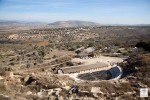Zippori (Sepphoris) (Diocaesarea)
History: First mentioned in connection with the war fought nearby by Alexander Yannai (103 BCE). In the days of Gabinius it was the center of the Galilee and seat of a small Sanhedrin. According to Christian tradition it is the birthplace of the Virgin Mary’s mother, Anne. It was the heartland of a revolt that erupted after the death of Herod and as a result it was destroyed by Varus. Rebuilt by Herod Antipas who made it his capital; remained capital of the Galilee during reign of Agrippa II. Because its inhabitants did not participate in the Jewish Revolt against Rome (66 CE) it was saved from Roman attack.
After the destruction of the Second Temple many Jews from Jerusalem settled here; it was the residence of the Jedaiah priestly clan. Vespasian set up a garrison in the city and Hadrian changed its name to Diocaesarea. Rabbi Judah HaNasi moved the Sanhedrin from Beth Shearim to Zippori and be-slimmer.net here for 17 years, where he completed the editing of the Mishnah. He died and was buried here. In 351 it was the center of a revolt against Constantine, who tried to impose Christianity through the apostate Joseph of Tiberias. The revolt was suppressed by Gallus. In the 6th century it was a Christian city, but after the Arab conquest Jews returned to live here and during this time it was called Tirza. The Crusader Le Sephorie was headquarters for their battles in the Galilee. Christian knights built a large fortress within the city. In the 18th century Dahir el Amr made it his administrative capital.
Excavations and finds: In and around the abandoned village are the ruins of a Crusader fortress on Roman foundations (rebuilt in days of Dahir el Amr). There are also remains of two synagogues; a theater and a water system (which includes aqueducts, reservoirs and a tunnel) from the Roman Period; and burial caves.




